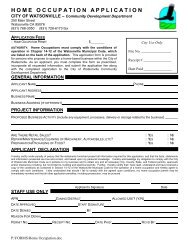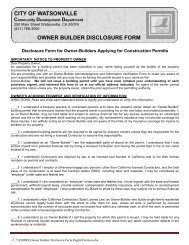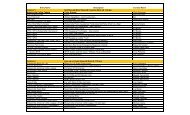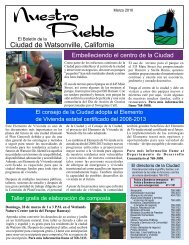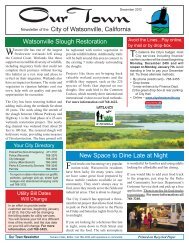Vegetation Management and Maintenance Plan - Watsonville ...
Vegetation Management and Maintenance Plan - Watsonville ...
Vegetation Management and Maintenance Plan - Watsonville ...
Create successful ePaper yourself
Turn your PDF publications into a flip-book with our unique Google optimized e-Paper software.
applications will be needed to control new flushes of weeds. Recent work has also examined<br />
essential oils as potential herbicides. It was found that clove oil or cinnamon oil at concentrations<br />
of 1 to 5% controlled most small weeds. The use of organic sprays could be evaluated for use<br />
within the VMMM project area as part of a pilot project.<br />
3.1.7 Flaming/ Selective Burning<br />
Within the VMMM project area, flaming/selective burning is a suitable treatment for many<br />
invasive weeds during the seedlings stage or growth of new shoots. This management option<br />
should prove effective with French broom, Harding grass, <strong>and</strong> some annual weeds. Flaming or<br />
selective burning should be done under strict guidelines related to safety, moisture <strong>and</strong> the life<br />
history stage of target species. Larger scale prescribed burning is an option unlikely to be<br />
acceptable, due to the limited number of isolated large patches of invasive weeds <strong>and</strong> the<br />
extensive effort required to coordinate a prescribed burn.<br />
3.1.8 Selective Grazing/Browsing<br />
Within the VMMM project area, selective grazing/browsing is a suitable treatment for Harding<br />
<strong>and</strong> canary grass. Potentially effective grazing animal species may be limited, due to several<br />
factors. Sheep are adversely affected by Harding grass <strong>and</strong> goats are browsers, rather than<br />
grazers. However, due to the fencing/containment needs for grazing animals, the aquatic nature in<br />
which the Harding/canary grass is found, animal-safety concerns, <strong>and</strong> existing recreational uses,<br />
grazing as an invasive weed control treatment may be limited. One potentially suitable area is the<br />
relatively confined area along Middle Struve Slough, immediately downstream of Main Street.<br />
Although goats are browsers, they may prove helpful in reducing the amount of poison hemlock,<br />
wild radish, fennel, <strong>and</strong> Harding grass. They remove biomass, thereby lowering green waste<br />
removal costs. Additionally, they increase the ability of personnel to access areas <strong>and</strong> roots of<br />
some invasive plants. Revegetation will be required in all cases where goats are utilized. Because<br />
goats do not kill many invasive plant species, re-infestations by aggressive, surviving invasive<br />
plants may limit the success of revegetation, unless secondary control methods are utilized in<br />
conjunction with the use of goats. The effectiveness of goats is predicated on a number of<br />
additional factors, as presented below:<br />
• Goats should not be utilized on slopes, soils, or in habitats where erosion is likely to<br />
occur, unless an acceptable, effective erosion control plan is created <strong>and</strong> provided for,<br />
prior to the arrival of the herd.<br />
• Goats often require regular active management <strong>and</strong> almost always require rapid response<br />
capabilities, by the goat providers. Specific conditions as to management <strong>and</strong> response<br />
requirements should be placed into contracts to assure compliance. Proximity to more<br />
desirable food <strong>and</strong> delays in proper management or response may result in destruction of<br />
desirable vegetation, both inside <strong>and</strong> outside the fenced area, including the girdling of<br />
riparian trees. Increases in erosion or sedimentation may also occur.<br />
• Goats are much more likely to eat certain plant species. Some plants will be eaten only<br />
when nothing else is available, reducing the effectiveness <strong>and</strong> increasing the cost of<br />
utilizing goats.<br />
• Goats do not kill many invasive plants. The survival of many plants results in the need<br />
for repeated visits, over a number of years. Additionally, other methods will be needed in<br />
conjunction with the use of goats to achieve success.<br />
• Safety <strong>and</strong> health concerns must be addressed for the goats <strong>and</strong> people who may come in<br />
contact with them.<br />
<strong>Vegetation</strong> <strong>Management</strong> <strong>and</strong> <strong>Maintenance</strong> Manual<br />
Draft 20 July 27, 2007




